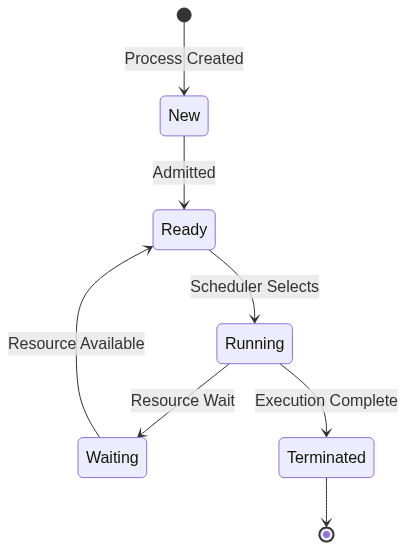Day 01: Deep Dive into Process Concepts in Operating Systems
Table of Contents
- Introduction
- What is a Process?
- Process Definition and Components
- Process Memory Layout
- Process States
- Process Control Block (PCB)
- Practical Implementation
- Code Example
- References and Further Reading
- Conclusion
- Learning Pathway
1. Introduction
In the intricate world of operating systems, understanding processes forms the fundamental building block of computational execution. This comprehensive exploration will unravel the complexities of processes, providing you with a deep, low-level understanding of how modern operating systems manage computational tasks.
2. What is a Process?
A process is a dynamic instance of a computer program during execution. Unlike a static program stored on disk, a process represents an active entity with its own resources, memory space, and execution context. It’s essentially a program in action, containing not just the code but all the computational resources required for its execution.
Key Characteristics of Processes:
- Dynamic Execution: Active program with ongoing computational state
- Resource Allocation: Dedicated memory, CPU time, and system resources
- Independent Execution Context: Isolated memory space and execution environment
3. Process Definition and Components
A process comprises several critical components that define its structure and behavior:
a. Program Code (Text Section)
- Contains the compiled machine instructions
- Read-only and shared among process instances
- Represents the static algorithmic logic of the program
b. Data Section
- Stores global and static variables
- Divided into initialized and uninitialized data
- Provides persistent storage for program-wide data
c. Stack
- Manages function call mechanisms
- Stores local variables, function parameters
- Supports dynamic memory allocation for function executions
- Grows and shrinks during program runtime
d. Heap
- Dynamic memory allocation area
- Used for runtime memory requests
- Managed manually in languages like C (malloc/free)
- Provides flexible memory management
4. Process Memory Layout
Modern operating systems organize process memory in a structured manner:
High Memory Address
+---------------------------------------------------+
| Kernel Virtual |
| Address Space |
| ◆ Kernel code, data, and modules |
| ◆ Shared across all processes |
+---------------------------------------------------+
| Stack |
| ◆ Dynamic memory for function calls |
| ◆ Local variables |
| ◆ Grows downward ↓ |
+---------------------------------------------------+
| Heap |
| ◆ Dynamic memory allocation |
| ◆ malloc(), new() |
| ◆ Grows upward ↑ |
+---------------------------------------------------+
| Uninitialized Data |
| ◆ BSS segment |
| ◆ Zero-initialized static variables |
+---------------------------------------------------+
| Initialized Data |
| ◆ Data segment |
| ◆ Initialized global and static variables |
+---------------------------------------------------+
| Program Text |
| ◆ Text segment |
| ◆ Executable instructions |
| ◆ Read-only memory |
+---------------------------------------------------+
| Kernel Space |
| ◆ Per-process kernel data structures |
| ◆ Page tables |
+---------------------------------------------------+
| Kernel Direct Mapping |
| ◆ Direct mapping of all physical memory |
+---------------------------------------------------+
| Kernel Dynamic Memory |
| ◆ Memory for kernel modules |
| ◆ vmalloc() allocation |
+---------------------------------------------------+
Low Memory Address
Key Characteristics
-
Memory Organization: The process memory is organized from high to low addresses, with different segments serving specific purposes.
- Dynamic Regions:
- Stack: Grows downward, used for function call management
- Heap: Grows upward, used for dynamic memory allocation
- Static Memory Regions:
- Uninitialized Data (BSS): Zero-initialized static variables
- Initialized Data: Initialized global and static variables
- Program Text: Read-only executable instructions
- Kernel Spaces:
- Kernel Virtual Address Space: Shared kernel resources
- Per-process Kernel Space: Process-specific kernel data
- Kernel Direct Mapping: Physical memory mapping
- Kernel Dynamic Memory: For kernel modules and allocations
Note: We will go more in-depth on this topic in the future.
5. Process States
A process transitions through multiple states during its lifecycle:
- New: Process being created
- Ready: Prepared for execution, waiting for CPU allocation
- Running: Currently executing instructions
- Waiting: Paused, waiting for external event (I/O, resource)
- Terminated: Execution completed, resources being deallocated
6. Process Control Block (PCB)
The Process Control Block is a data structure containing critical process metadata:
- Process ID (PID)
- Process State
- Program Counter
- CPU Registers
- CPU Scheduling Information
- Memory Management Details
- Accounting Information
7. Practical Implementation
Process Creation Mechanisms
Processes can be created through:
- System initialization
- User request to create new process
- Spawning child processes
- Batch job scheduling
8. Code Example: Process Information Demonstration
#include <stdio.h>
#include <unistd.h>
#include <sys/types.h>
int main() {
pid_t process_id = getpid(); // Current process ID
pid_t parent_process_id = getppid(); // Parent process ID
printf("Current Process ID: %d\n", process_id);
printf("Parent Process ID: %d\n", parent_process_id);
return 0;
}
9. References and Further Reading
- Silberschatz, A., Galvin, P. B., & Gagne, G. (2018). Operating System Concepts
- Tanenbaum, A. S. (2006). Modern Operating Systems
- Linux Manual Pages (man7.org)
- IEEE POSIX Standards Documentation
10. Conclusion
Processes represent the fundamental unit of computation in modern operating systems. Understanding their structure, lifecycle, and management provides insights into how computers execute complex computational tasks efficiently and systematically.
Key Takeaways:
- Processes are dynamic, active program instances
- They have structured memory layouts
- Multiple states govern their execution
- Process Control Blocks manage critical metadata
11. Learning Pathway
This exploration of process concepts sets the foundation for understanding advanced operating system principles. In subsequent days, we’ll dive deeper into process states, creation mechanisms, and scheduling algorithms.
Next in Series: Day 2 - Process States and Transitions
Note: Code examples and demonstrations are best understood through practical execution and experimentation.
